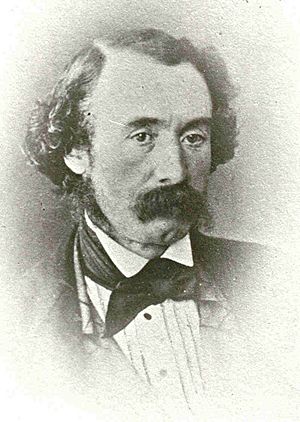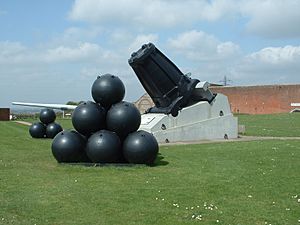Robert Mallet facts for kids
Quick facts for kids
Robert Mallet
|
|
|---|---|
 |
|
| Born | 3 June 1810 |
| Died | 5 November 1881 (aged 71) Clapham, London
|
| Nationality | Irish |
| Education | Trinity College in Dublin |
| Occupation | Engineer |
| Children | John William Mallet, Frederick Richard Mallet |
| Engineering career | |
| Institutions |
|
| Projects | Fastnet Rock lighthouse |
| Awards |
|
Robert Mallet (3 June 1810 – 5 November 1881) was an Irish geophysicist and civil engineer. A geophysicist studies the Earth using physics. A civil engineer designs and builds things like roads and bridges.
Mallet was also an inventor. He is famous for his research on earthquakes. Some people call him the "father of seismology". Seismology is the scientific study of earthquakes. His son, Frederick Richard Mallet, also became a geologist.
Contents
Early Life and Education
Robert Mallet was born in Dublin, Ireland, on June 3, 1810. His father, John Mallet, owned a factory.
Robert went to Trinity College, Dublin when he was 16. He studied science and math. He finished his studies in 1830, at the age of 20.
Engineering Career
After college, Robert joined his father's iron business. An iron foundry is a place where metal is melted and shaped. They made the business one of the most important engineering companies in Ireland.
They built iron parts for railways. They also supplied ironwork for the Fastnet Rock lighthouse. Another project was a swing bridge over the River Shannon at Athlone. Mallet's company also made the iron railings around Trinity College. You can still see his family name on them.
Mallet joined the Royal Irish Academy in 1832. He was only 22 years old. In 1835, he joined the British Association for the Advancement of Science. This group helped pay for much of his earthquake research.
He became a member of the Royal Geological Society of Ireland in 1838. He was even its President from 1846 to 1848. From 1848 to 1849, he helped build the Fastnet Rock lighthouse. This lighthouse is southwest of Cape Clear Island.
Studying Earthquakes
Robert Mallet is a very important figure in the study of earthquakes. On February 9, 1846, he shared a paper with the Royal Irish Academy. It was called "On the Dynamics Of Earthquakes". This paper is seen as the start of modern seismology.
He also created the word "seismology" itself. He invented other related words too. One was the isoseismal map. This map shows areas that had the same earthquake intensity. He also came up with the term epicentre. The epicentre is the point on the Earth's surface directly above where an earthquake starts.
From 1852 to 1858, Mallet worked with his son, John William Mallet. They created The Earthquake Catalogue of the British Association. This book listed many earthquakes. He also did experiments using explosions. He wanted to find out how fast earthquake waves travel through sand and rock.
The Great Neapolitan Earthquake
On December 16, 1857, a huge earthquake hit Padula, Italy. It was called the Great Neapolitan earthquake. About 11,000 people died. It was one of the biggest earthquakes known at that time. Scientists now think it was about a 7.0 magnitude earthquake.
Mallet asked the Royal Society in London for money. He wanted to go to Italy and study the damage himself. He received £150 for his trip. He wrote a report called the Report on the Great Neapolitan Earthquake of 1857. This was a major scientific work. He used the new invention of photography to show the damage.
In 1862, he published a two-volume book. It was titled "Great Neapolitan Earthquake of 1857: The First Principles of Observational Seismology". In this book, he showed that the earthquake started about 8 to 9 miles below the Earth's surface.
Mallet also wrote a paper called Volcanic Energy. In it, he suggested that heat from volcanoes comes from the Earth's crust moving and breaking. When the crust breaks, water can get in. If it gets hot enough, it can cause volcanic eruptions of steam or lava.
Other Inventions and Later Life
During the Crimean War, Mallet designed a huge mortar. A mortar is a type of cannon that fires shells high into the air. His mortar weighed 42 tons and had a 36-inch wide barrel. It could fire a 2400-pound shell about 1.5 miles.
The mortar was built in parts so it could be moved. However, it was finished too late to be used in the war. You can see an example of Mallet's Mortar at the Royal Artillery base in Woolwich. Another is at Fort Nelson near Portsmouth.
Mallet became a Fellow of the Royal Society in 1854. In 1861, he moved to London. There, he worked as a consulting engineer. He also edited a magazine called The Practical Mechanic's Journal.
He received several important awards for his work. These included the Telford Medal in 1859. He also won the Cunningham Medal in 1862 for his earthquake research. In 1877, he received the Wollaston medal, which is a very high award in geology.
Robert Mallet became blind in the last seven years of his life. He passed away in London on November 5, 1881. He is buried at West Norwood Cemetery.
Images for kids



